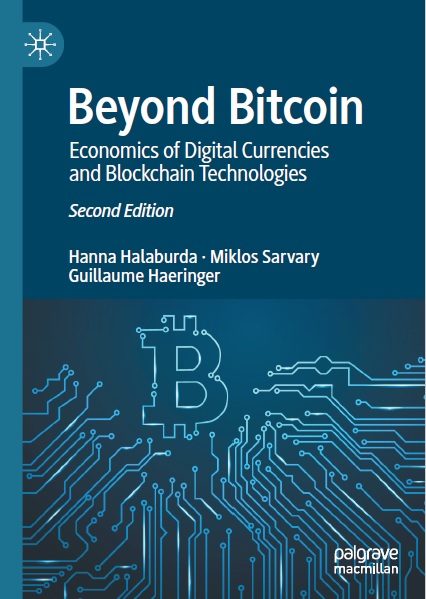Beyond Bitcoin: Economics of Digital Currencies and Blockchain Technologies, Second Edition
By Hanna Halaburda, Miklos Sarvary and Guillaume Haeringer

Contents:
1 Introduction 1
2 Means of Exchange: Ever-Present Competition 9
2.1 The Medium of Exchange—Historical Overview 10
2.2 What Roles Does Money Serve? 17
2.3 Competing Money 25
2.3.1 Coexistence Is Costly 26
2.3.2 Network Effects 30
2.3.3 The Difficulty of Introducing a New Currency:
Excess Inertia 33
2.3.4 Coexistence of Various Currencies 35
3 Platform-Based Currencies 39
3.1 Special Currencies of the Traditional World 44
3.2 Platform-Based Currencies in the Digital Era 47
3.2.1 Online Video Games—The Case World of Warcraft Gold 51
3.2.2 Virtual Worlds and Linden Dollars 57
3.2.3 Social Networks and Facebook Credits 62
3.2.4 Promotion Platforms and Amazon Coin 68
3.3 Conclusion 73
3.4 Are Restricted Currencies Really Currencies? 74
4 Bitcoin and Arrival of Cryptocurrencies 75
4.1 The Double-Spending Problem 78
4.2 A Brief Overview of Bitcoin’s Design 80
4.3 Not the First One—Predecessors of Bitcoin 89
4.4 New Challenges Created by Bitcoin Design 92
4.4.1 Mining Arms Race and Electricity Consumption 92
4.4.2 Mining Pools and Centralization Propensity 95
4.4.3 Threat of Attacks 96
4.4.4 Deflationary Pressure 99
4.4.5 Governance 101
4.5 How Do bitcoin’s Attributes Compare to Earlier Money? 104
5 The Rich Landscape of Crypto 107
5.1 Improving Currency Functionality 109
5.2 Proof-of-Stake 111
5.3 Privacy Coins 116
5.4 Proliferation and Eventual Decline of Altcoins 119
5.5 The Emergence of Tokens 123
5.6 Stablecoins 125
5.7 Trading Crypto 128
6 Smart Contracts and Blockchain 135
6.1 The Rise of Ethereum 136
6.1.1 History 136
6.1.2 Ethereum Is “Different” 138
6.2 Smart Contracts 147
6.2.1 Smart Contracts on Ethereum 147
6.2.2 What Do Smart Contracts Need a Blockchain For? 152
6.3 Tokens 154
6.3.1 What Are Tokens? 155
6.3.2 Use of Tokens 158
6.4 Initial Coin Offering 159
6.5 Non-fungible Tokens 163
6.5.1 NFTs and Smart Contracts Do Not Solve
Digital Art Ownership Problems 165
6.5.2 New Markets Enabled by NFTs 169
6.6 Dapps 172
6.7 Blockchain Governance, Dapp Governance, and Smart Contracts 175
7 Enterprise Blockchains 179
7.1 Distributed Database: What Is It and What For? 179
7.2 Limitation of Bitcoin’s Blockchain for Enterprise Use 182
7.3 Consensus for Permissioned Distributed Systems 184
7.4 Enterprise Blockchain Solutions 188
7.5 Government Applications 191
8 Future Full of Possibilities 197
References 201
Index 205
Preface
Beyond Bitcoin has emerged from endless discussions between Hanna and Miklos that go back to 2014. Back then, “cryptocurrency” really meant “Bitcoin” and it appeared that it might remain only a marginal chapter in the digitization of finance. Instead, the lead players were large platforms that started experimenting with centralized digital currencies to further leverage their huge audiences. The book’s title reflects our prediction at the time that centralized currencies by private platforms are likely to have a dominant role in the future of finance. In subsequent years, cryptocurrencies have come back with a vengeance, with variety driven by unprecedented innovation but also with clearer economic significance as an asset class, as a payment system, or as a serious environmental concern.
This major change has sparked renewed interest in the book, leading our Editor to ask us to write a second edition. It was immediately clear that the second edition of the book needed a major upgrade because a variety of innovations have completely changed the crypto landscape. Important new developments, such as ICOs and smart contracts had to be addressed. Moreover, academic research on cryptocurrencies has exploded in the last five years. We needed new expertise and we were fortunate that Guillaume joined our team. He brought a new perspective on the industry and a deep knowledge of relevant academic research. We were happy to see that our discussions haven’t lost any of their intensity, even though most of them were conducted over Zoom during the Covid-19 pandemic.
The world of cryptocurrencies is far from a stable, settled state. On the one hand, we all realize the importance and the future potential of cryptocurrencies in complementing or even renewing the world’s financial plumbing. On the other hand, one cannot ignore the systemic risk that cryptocurrencies may represent for the world economy. This risk has not escaped the attention of governments all over the world. Regulators everywhere are trying to implement a framework that balance the need for financial stability with the possibility of further innovations. It is in this extraordinary context that, we believe, the second edition can help interested readers better understand the economics of digital currencies.
Hanna Halaburda- New York, USA
Miklos Sarvary- New York, USA
Guillaume Haeringer- New York, USA
